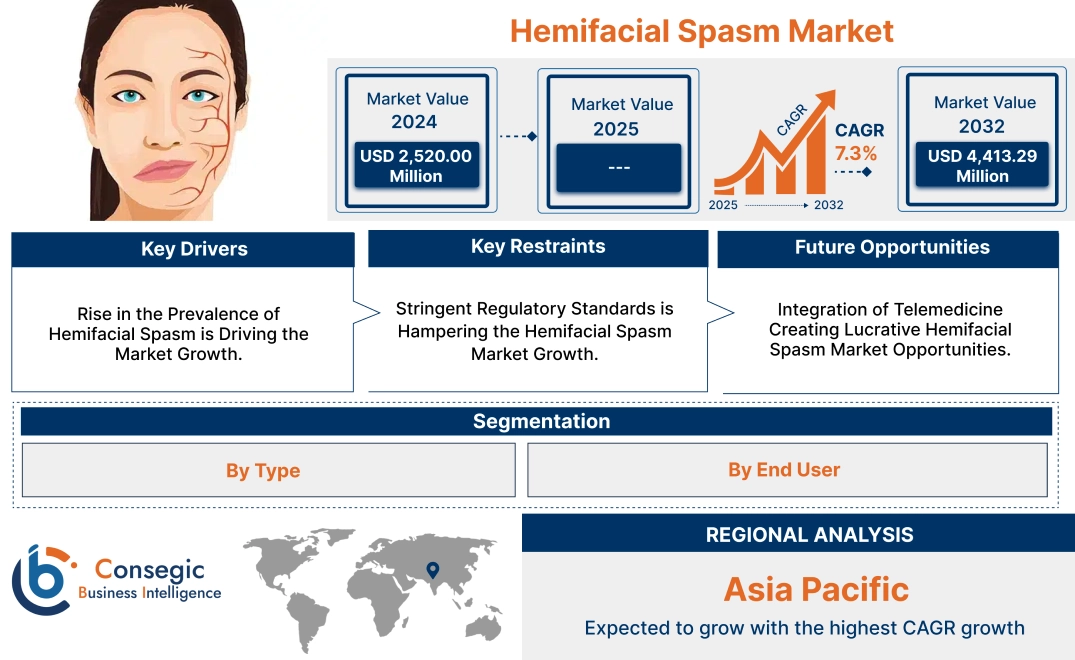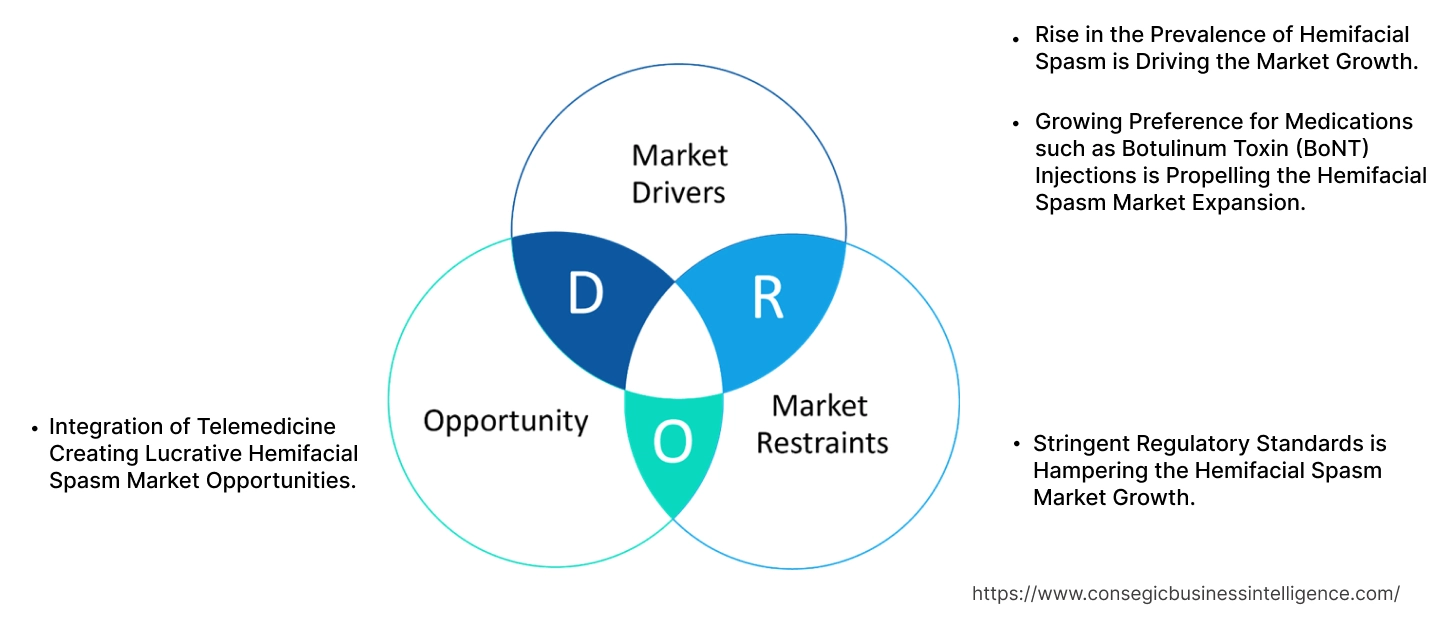- Summary
- Table Of Content
- Methodology
Hemifacial Spasm Market Size:
Hemifacial Spasm Market size is growing with a CAGR of 7.3% during the forecast period (2025-2032), and the market is projected to be valued at USD 4,413.29 Million by 2032 from USD 2,520.00 Million in 2024.
Hemifacial Spasm Market Scope & Overview:
Hemifacial Spasm (HFS) is a rare neurological disorder that generally causes involuntary contraction of the muscles that are present at the side of the face. The symptom of this condition generally begins with twitching of eyelids. This spasm gradually spread to other facial muscles, including the cheek, mouth, and neck.
The spasm is diagnosed through tests such as MRI, CT scan, angiography, and electromyography among others. They are treated through various options including medications, surgery, transcutaneous electrical nerve stimulation therapy, physical therapy, and others. The end-user includes hospitals & clinics, ambulatory surgical centres, and homecare settings among others.
Key Drivers:
Rise in the Prevalence of Hemifacial Spasm is Driving the Market Growth.
Rise in the prevalence is mainly caused because of the pressing of the facial nerve at a point where it exits the brain stem. The condition is associated with certain neurological conditions, such as multiple sclerosis or brain stem tumor. It mainly affects individuals with middle age or older, with the most common age ranging between 45-60 years old. Additionally, women are more likely to develop this condition than men.
For instance,
- According to the data published by the National Library of Medicine, in 2024, states that the worldwide prevalence of HFS is 14.5 per 100,000 and 7.4 per 100,000 men, which states that women are twice as susceptible to this condition than men.
Hence, the vascular changes because of compressed facial nerve, and neurological conditions among others are factors contributing to the prevalence of the condition, thus driving the hemifacial spasm market growth.
Growing Preference for Medications such as Botulinum Toxin (BoNT) Injections is Propelling the Hemifacial Spasm Market Expansion.
Botulinum Toxin (BoNT) Injections commonly known as Botox are medical treatment that mainly involves injecting small amounts of purified protein that is produced by the bacterium clostridium botulinum. For treatment of this condition the injection works by temporarily paralyzing the overactive facial muscles that cause involuntary contractions. This offers enhanced efficacy and improves the quality of life of the individuals suffering from HFS.
For instance,
- According to the data published by the National Library of Medicine in 2023, according to the study conducted on large scale studies, the efficacy of BoNT ranges from 78% to 98%.
Thus, the rise in the preference for botulinum toxin injections for effective treatment is influencing the hemifacial spasm market demand.
Key Restraints:
Stringent Regulatory Standards is Hampering the Hemifacial Spasm Market Growth.
Stringent regulatory standards imposed by government bodies worldwide pose significant constraints in the Hemifacial Spasm market. These regulations, designed to protect the environment and public health, increase production costs and slow the development of the product. Rigorous clinical trials and regulatory approvals are necessary for the introduction of new devices and treatments. This leads to the rise in the time and investment required by the companies to launch new therapies in the market.
This complex and lengthy procedures hinder the demand and introduction of innovative technologies and therapies. The cost of navigating the regulatory landscape, including clinical trials and regulatory submissions influences the rise in the overall development cost of therapies and medication. Thus, the impact of these stringent regulations on the Hemifacial Spasm market expansion is multifaceted.
Future Opportunities :
Integration of Telemedicine Creating Lucrative Hemifacial Spasm Market Opportunities.
Telemedicine platforms facilitate remote consultation, allowing patients in remote areas to access that specialized neurologist for diagnosis and treatment planning, including botulinum toxin injections. This approach enhances patients access to care, improves treatment adherence, and reduce the burden of travel for both patient and healthcare provider.
Additionally, telemedicine enables remote monitoring of treatment outcomes and facilitates timely adjustments to treatment plans, optimizing patient care and potentially leading to improved medical outcomes.
For instance,
- In 2024, Avel eCare, a provider of clinician-to-clinician telemedicine services, announced the launch of Avel eSync, an exclusive clinical workflow platform designed to enhance its service offerings and enable organizations to effectively use critical telemedicine solutions.
Thus, the introduction of novel telemedicine platforms is creating potential hemifacial spasm market opportunities in the coming years.
Hemifacial Spasm Market Segmental Analysis :
By Type:
Based on type, the market is categorized into diagnosis and treatment
Trends in the Type:
- Rise in the trend for personalized medicine and treatment is influencing the segment
- The development of advanced imaging solutions is propelling the segment.
The treatment segment accounted for the largest hemifacial spasm market share in 2024 and is expected to grow at the fastest CAGR over the forecast period.
The treatment segment is further categorized into medications, surgery, transcutaneous electrical nerve stimulation therapy, physical therapy, and others.
- Treatment for hemifacial spasm aims to reduce or eliminate involuntary muscle contractions.
- The most common and effective treatment is Botulinum toxin (Botox) injections.
- These injections temporarily paralyze the affected muscles, providing significant relief for many patients.
- Other treatment options include medications such as anticonvulsants or muscle relaxants, which may be used in conjunction with Botox.
- For severe cases, surgical intervention, such as microvascular decompression, are considered to relieve pressure on the facial nerve.
- Microvascular decompression shows a positive success rate.
- For instance, according to the data published in the article by Aaron Cohen-Gadol, in 2024, states that individuals undergoing microvascular decompression treatment shows a success rate of 80%.
- Thus, based on the market analysis, the aforementioned factors are influencing the hemifacial spasm market expansion.
By End Use:
Based on end user, the market is categorized into hospital & clinics, ambulatory surgical centers, home care settings, and others
Trends in the End User:
- Rise in trend for specialty clinics with novel equipment is influencing the growth of the segment.
- The rise in the trend for same day delivery is influencing the ambulatory surgical center.
The hospital segment accounted for the largest market share of 53.56% in the year 2024.
- Hospitals and clinics play a crucial role in the diagnosis and treatment of HFS.
- Hospitals and clinics are equipped with advanced diagnostic tools such as magnetic resonance imaging (MRI) to identify the underlying cause of HFS, often a blood vessel compressing the facial nerve.
- They also offer a range of treatment options, including botulinum toxin injections (Botox), the most common treatment for HFS, as well as surgical interventions like microvascular decompression for severe cases.
- For instance, in 2024, Fortis Hospital announced the launch of the first dedicated Movement Disorder & DBS Clinic in India. This specialized clinic provides comprehensive care for patients suffering from a range of movement disorders, including Parkinson's disease, essential tremor, dystonia, and hemifacial spasm.
- Thus, as per the market analysis, these factors are influencing the hemifacial spasm market trends.
The ambulatory surgical centers segment is expected to grow at the fastest CAGR over the forecast period.
- Ambulatory surgical centers play a crucial role in the treatment of hemifacial spasm, particularly for procedures like botulinum toxin (Botox) injections. These centers offer a convenient and cost-effective alternative to traditional hospital settings for minimally invasive procedures.
- Ambulatory surgical centers are equipped to administer Botox injections safely and efficiently, allowing patients to receive treatment in a comfortable and outpatient setting.
- This eliminates the need for hospitalization, reduces recovery time, and allows patients to return to their daily activities more quickly.
- Furthermore, based on the market analysis, ambulatory surgical centers often have shorter wait times compared to hospitals, making it easier for patients to schedule and receive timely treatment. Thus, this accessibility significantly improves treatment outcomes and enhances the overall patient experience.
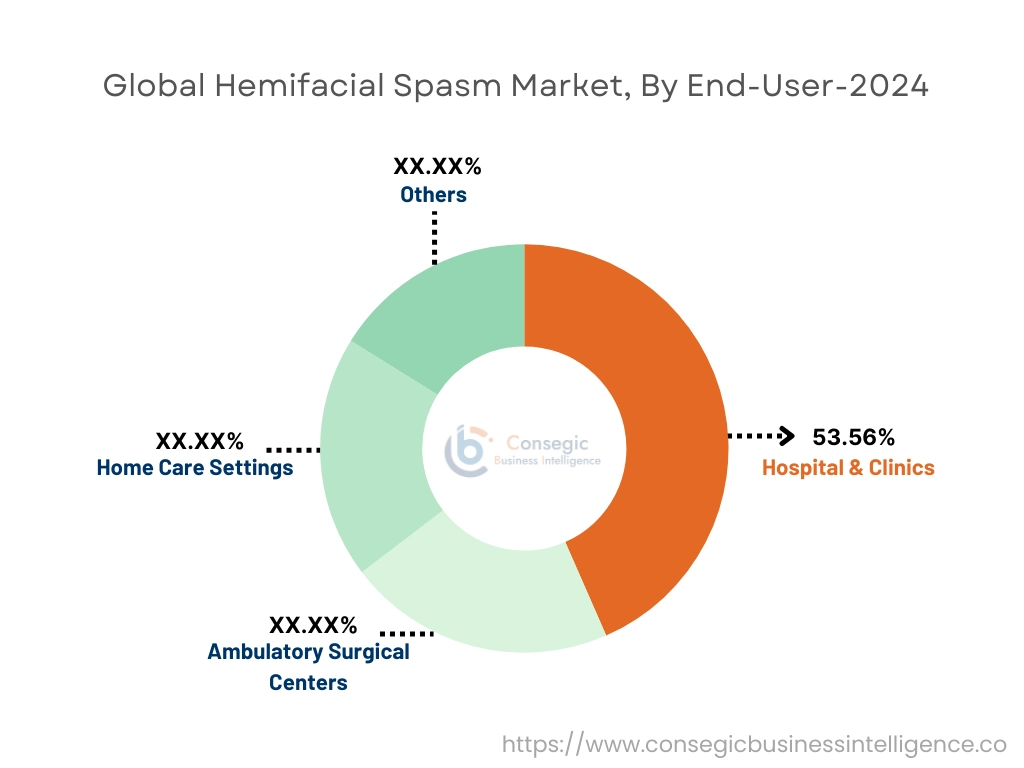
Regional Analysis:
The regional segment includes North America, Europe, Asia Pacific, the Middle East and Africa, and Latin America.
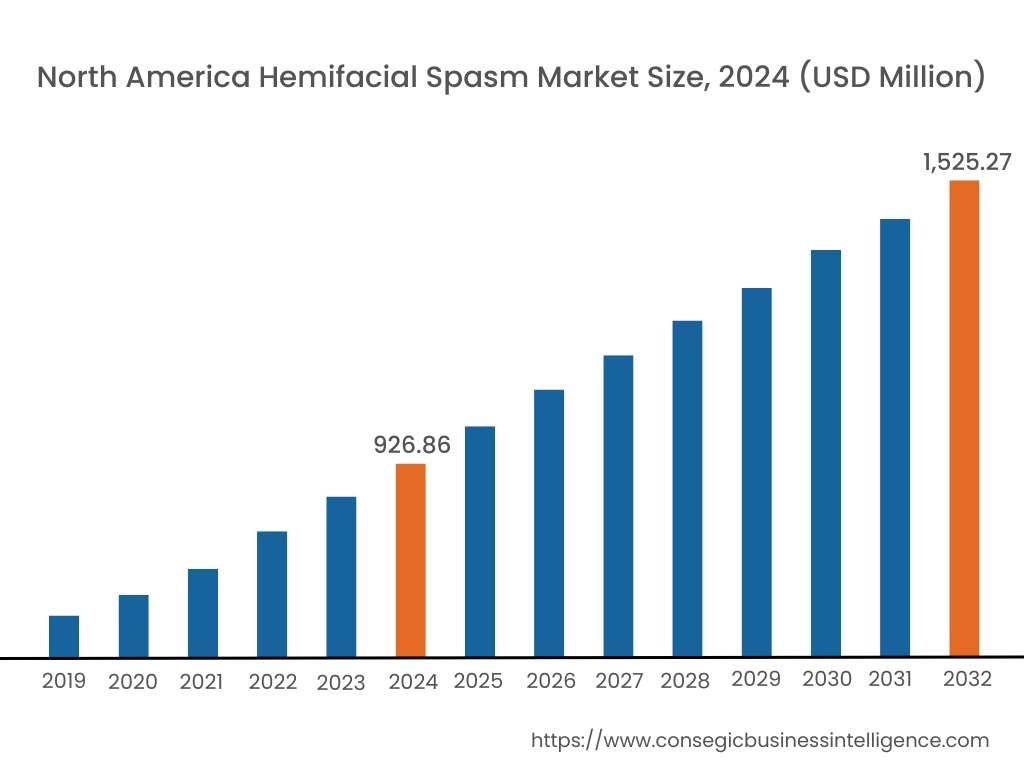
In 2024, North America accounted for the highest hemifacial spasm market share at 36.78% and was valued at USD 926.86 Million and is expected to reach USD 1,525.27 Million in 2032. In North America, U.S. accounted for the highest market share of 71.62% during the base year of 2024.
The Hemifacial Spasm market trend across the region is attributed to factors such as the presence of a well-developed healthcare infrastructure. This includes factors such as readily available diagnostic facilities, access to specialized neurologists and neurosurgeons, and the availability of advanced treatment options like botulinum toxin injections and microvascular decompression surgery. These factors influence the healthcare spending in this region.
For instance,
- According to the data published by the American Medical Association, in 2024, states that health spending in the U.S is increased by 4.1% in 2022 since 2019.
Thus, based on the market analysis, the growth of healthcare industry and rise in the health segment is influencing the hemifacial spasm market demand and trends.
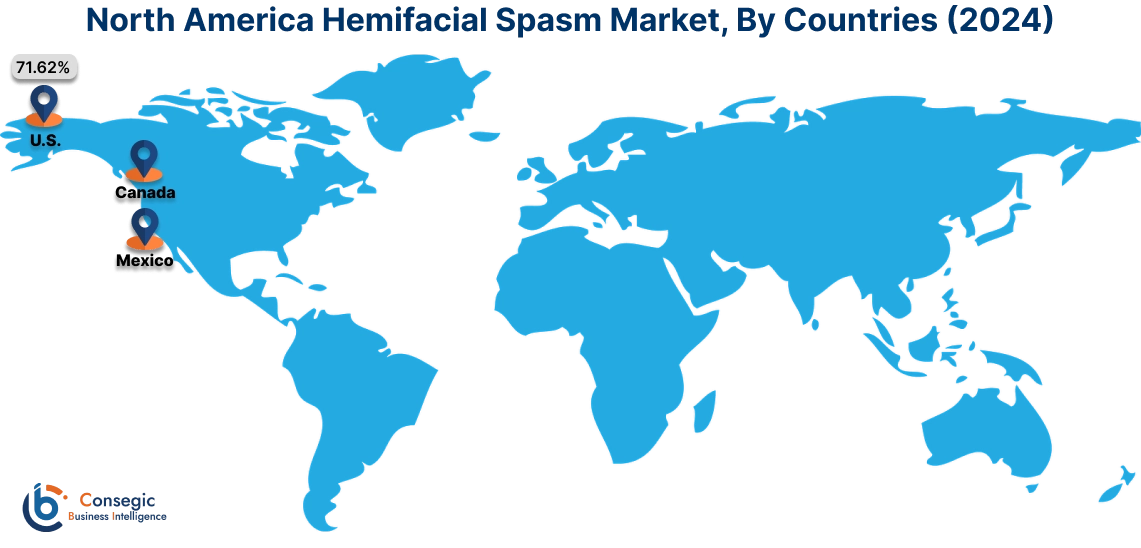
Asia Pacific is experiencing the fastest growth with a CAGR of 8.5% over the forecast period. Hemifacial spasm has a significant impact on healthcare spending in the Asia-Pacific region. HFS is considered more common in Asian populations. The rising prevalence of neurological disorders, coupled with an aging population, is contributing to a growing number of HFS cases. The escalating incidence of neurological disorders, coupled with an aging demographic, further contributes to a rising number of HFS cases. A growing number of hospitals translates to increased access to the healthcare industry for a larger population. This includes improved access to treatment options like botulinum toxin injections, and ongoing management of HFS. Thus, based on the hemifacial spasm market analysis, these factors are influencing the growth of the market in this region.
Europe presents a significant contribution to the Hemifacial Spasm market analysis. Advancements in imaging technology in Europe have significantly improved the diagnosis and treatment of this condition. High-resolution magnetic resonance imaging (MRI) techniques, including 3D time-of-flight magnetic resonance angiography (3D TOF MRA), have become crucial for visualizing the neurovascular compression, where a blood vessel, mainly an artery, presses on the facial nerve. Imagining provides valuable information about the degree of contact between the blood vessel and the nerve, helping to determine the most appropriate strategy. These advanced imaging techniques provide detailed anatomical information, aiding in detailed planning for microvascular decompression surgery and improving surgical outcomes.
The Middle East and Africa (MEA) region is witnessing notable market demand and share characterized by significant potential. Awareness and government initiatives regarding neurological disorders, including Hemifacial Spasm, vary across the Middle East and Africa. While some countries have taken initiatives in raising awareness through public health campaigns and patient support groups, challenges remain, such as limited access to specialized healthcare industry, lack of trained neurologists, and inadequate healthcare industry. Government initiatives also include funding research, supporting training programs for healthcare professionals, and developing national guidelines for the diagnosis and management of neurological disorders. Thus, these factors are influencing the demand of the market in this region.
Transcutaneous Electrical Nerve Stimulation (TENS) therapy offers a valuable factor to the management of hemifacial spasm in the Middle East and Africa. Clinics in these regions leverage TENS as a non-invasive and potentially cost-effective option, particularly for patients who are suitable for surgical intervention or as a complementary approach to enhance the effects of other treatments like botulinum toxin injections. TENS therapy also provides symptom relief and improves a patient’s quality of life while minimizing the need for more invasive procedures. While access to specialized clinics offering TENS varies across the region, its potential as a valuable therapeutic tool for managing this condition in these settings ensure further exploration and increased accessibility.
Top Key Players and Market Share Insights:
The global Hemifacial Spasm market is highly competitive with major players providing precise products to the national and international markets. Key players are adopting several strategies in research and development (R&D) and product innovation to hold a strong position in the global market. Key players in the global Hemifacial Spasm market include-
- OMRON HEALTHCARE MALAYSIA SDN BHD (Malaysia)
- AbbVie (United States)
- Koninklijke Philips N.V. (Netherlands)
- SternMed GmbH (Germany)
- ALLERGAN (Ireland)
- GE HealthCare (United States)
- GlaxoSmithKline plc (United Kingdom)
- FUJIFILM Limited (Japan)
Hemifacial Spasm Market Report Insights :
| Report Attributes | Report Details |
| Study Timeline | 2019-2032 |
| Market Size in 2032 | USD 4,413.29 Million |
| CAGR (2025-2032) | 7.3% |
| By Type |
|
| By End-User |
|
| By Region |
|
| Key Players |
|
| North America | U.S. Canada Mexico |
| Europe | U.K. Germany France Spain Italy Russia Benelux Rest of Europe |
| APAC | China South Korea Japan India Australia ASEAN Rest of Asia-Pacific |
| Middle East and Africa | GCC Turkey South Africa Rest of MEA |
| LATAM | Brazil Argentina Chile Rest of LATAM |
| Report Coverage |
|
Key Questions Answered in the Report
How big is the Hemifacial Spasm market? +
In 2024, the Hemifacial Spasm market is USD 2,520.00 Million.
Which is the fastest-growing region in the Hemifacial Spasm market? +
Asia Pacific is the fastest-growing region in the Hemifacial Spasm market.
What specific segmentation details are covered in the Hemifacial Spasm market? +
Type, and End User segmentation details are covered in the Hemifacial Spasm market.
Who are the major players in the Hemifacial Spasm market? +
OMRON HEALTHCARE MALAYSIA SDN BHD (Malaysia), AbbVie (United States), ALLERGAN (Ireland) are some of the major players in the market.
